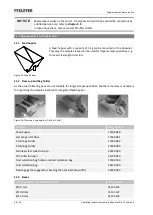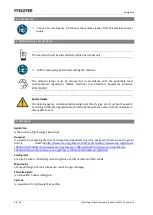
Operation
26 | 40
Operating instructions sample cleaner SLN 4 | Revision 4
7.3
Re-weighing
Calculation example:
The weight of the sample that you are pouring in the filling container is 1,050 g.
The cleaning process is started.
The aspiration is effective when the sample is discharged.
10 g dust and light dirt particles are sucked in.
Straw sieve and sand sieve sort 20 g of dirt particles each, i.e. total 40 g.
The weight of the sample that is to be sorted by the grading sieve is now 1,050 g – 50 g = 1,000 g.
The waste of 50 g has 4.8 % of the sample.
The remaining 1,000 g is the weight of the grains without waste that must be sorted:
1,000 g = 100 %!
After grading, the clean sample now has 850 g top goods and 150 g small grains (i. e. 85 % and 15 %).
Result of weighing:
Sample
1,050 g
Waste
50 g = 4.8 %
Top goods
850 g / 85 %
Small grains
150 g / 15 %
7.4
Sieve change
In order to avoid an unexpected starting of the sample cleaner, disconnect the
mains before changing the sieves.
The tension springs for the straw sieve, sand sieve and the grading sieves are clamped with holders on the
sieving trays.
Press the tension springs downwards and pull them forward.
In order to attain unrestricted space for the sieve-changing operation, rotate the springs in the
direction of the respective side wall.
The sieves are now ready to be changed.
Figure 14: Tension springs on sieving tray
Item Name
Item Name
1
Holder
4
Tension spring forwards
2
Tension spring
5
Tension spring towards side wall
3
Tension spring downwards
3
4
5
1
2















































